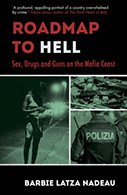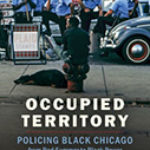Roadmap To Hell: Sex, Drugs And Guns On The Mafia Coast

Author: Barbie Latza Nadeau
Publisher: London: Oneworld Publications, 2018. 240 p.
Reviewer: Emanuele Sclafani | September 2019
Roadmap to Hell: Sex, Drugs and Guns on the Mafia Coast is a report on migrant Nigerian sex-trafficking activities along the Italian coasts, also known as the Mezzogiorno. This region acts as a crossroad for sex-traffickers and their potential victims. Through this journalistic investigation, Nadeau, an American journalist with a well-rounded knowledge of crime and political issues in Europe, offers the reader a journey into the human emotional dimensions of Nigerian women who are ‘the single largest group of victims trafficked to Europe for the forced sex slave trade in a racket everyone knows about but no one stops’ (p. 12). Through heart-wrenching stories of trafficked Nigerian women for sexual slavery in Castel Volturno, a city in the province of Caserta in the Campania Region, the author shows how sex trafficking is truly an international phenomenon.
The illusion of having a better life in Europe, black magic and physical harassment put these women who are most often uneducated and poor on a one-way road with little chance of salvation. By showing the changes of smuggling routes for sex traffickers, and following the trafficking in weapons trail, the author highlights the interwoven relationships between Nigerian criminal gangs and Italian mafias as they are driven by the same economic interest. This represents innovation and a break compared to the typical Italian organised crime modus operandi. Here, they engage in supplying arms to terrorist groups and helping them in recruiting mercenaries by assuring safe transit in Europe. Additionally, Nadeau underlines how corruption in the public and private sector in Italy and the lack of Italian supervisory bodies play an important role in facilitating these criminal activities. The role played by religious nuns complimented by the work of NGOs to free women from sex trafficking represents valuable work in this area, but it remains limited due to the magnitude of the phenomenon, and because ‘adequate prevention remains the biggest challenge and the only real way to stop the trafficking cycle’ (p. 194).
This book is thematically structured in seven chapters. Themes such as hope, fear, violence, racism, death, black magic and Christian charity constitute the fulcrum of the book, and they reveal various facets of this unconscionable industry. Drawing on interviews from various actors associated with the phenomenon and covering different roles in sex-trafficking and secondary data sources, Nadeau highlights the emotional side of the interviewees, and the weaknesses and the contradictions of the Italian political and legal systems. ‘Every nun, police officer, priest, prosecutor and aid worker who deals with the girls knows exactly how the corrupted system works, yet for some unthinkable reason no one has ever had the means, or maybe the will, to stop it’ (p. 12-13). The author effectively uses catchphrases and pertinent photographs to kick start every chapter, which leaves the reader with greater impact.
In the introduction, Nadeau sets the stage by describing the Italian context and its endemic corruption that promoted and proliferated sex-trafficking, particularly in southern Italy, due to the powerful presence of Italian mafias which capitalise on poor living and labour market conditions in this area. The expression ‘Africa begins in Rome’ exactly expresses poverty conditions faced by different areas of southern Italy (p. 3). The author highlights how the geo-political-socio-cultural and economic changes arising from recent conflicts in Europe have led to the emergent situation of an exodus from war-torn regions. Furthermore, these contingent situations created routes which later served the profit interests of flesh traders; these were previously used passages for migrants that were later transformed into routes for the sex trade. For example, the migrant crisis in 2009, where a large number of migrants from Africa arrived in Lampedusa, an Italian island in Sicily, was a wake-up alarm for what became a monumental problem of human tragedy. In one such example from the book, `Dolly’s’ story is one of the many depicting to what bad ends trafficked Nigerian women are destined in Italy, whether by choice or by force. The author indicates that such human consequences remain a result of the weaknesses of Italian instruments for immigration, of asylum or short-term help, as well as from the unsuitable migration policy adopted by the European Union which actually facilitated the growth of this illegal business. Additionally, legalisation of prostitution in Italy has led some people to consider these women not as victims of sex slavery, but as making conscious choices to sell sex. In this scenario ‘what is clear, is that without the NGOs, the death toll would be more absurd than it already is’ (p. 10).
In the ‘Rescued, then captured’ chapter, the reader gets a closer look at how the common traumatic personal experiences of Nigerian trafficked women to Italy lead them to bond over their tragic fate as being part of a community. Through `Joy’s’ story, the author demonstrates that poverty and lack of literacy continue to be the main causes for Nigerian women being easy prey for “maman” (mother in French) who are usually identified as ‘recruiters who find women in Nigeria for the Nigerian madams, or pimps, working in Europe’ (p. 16). Additionally, the JuJu Curse, an ancient African ritual based on an amalgamation of different religious beliefs, plays a key role in psychologically conditioning and manipulating women, leading to entrapment in debt bondage that is settled through becoming a sex slave. This is the ordeal faced by Nigerian women and others, moved by false promises of legitimate work, who are stripped of human dignity during their journey. The rescue and the reception of the lucky few who reach the Italian coast on dilapidated boats is a prelude to what they will go through later. ‘Migrants are treated as second-class citizens in the eyes of the law and in public perception’ (p. 40). The unfortunate state of reception centres continues to remain visual evidence of maltreatment in the public eye. For example, we learn from the case of Cara Mineo, which is a reception centre in the village of Mineo in central Sicily, that migrants become increasingly victimized the longer they stay in these types of camps. Indeed, the lack of security and the criminal operations in Cara Mineo have been confirmed by different investigations. ‘It is a punishing purgatory for migrants hoping to become refugees. It is also a hotbed for illicit activity, effectively sponsored and paid for by the Italian state’ (p. 25- 26). Moreover, the red tape associated with asylum requests, when documents often contain false information on the trafficked women, information provided by the traffickers, fuels the growth of an illegal black market economy especially in the agriculture sector, as well as with respect to the disappeared women forced into sex slavery. At the same time, Islamic State sympathisers, who are among the migrants or in the reception centre, act as facilitators in the process of radicalization and recruitment of foreign fighters. Chapter Two provides an insightful perspective into the social and spiritual work carried out by the Ursuline of the Sacred Heart of Mary nuns — through Casa Ruth, a shelter on the main street of Caserta — to restore dignity to these trafficked women. The whole area around Naples, known as la terra dei fuochi (Land of Fires) because of toxic waste dumped in the subsoil by the Camorra (the Neapolitan mafia), is indicative of the collusive and corruptive Italian system that undermines planning and socio-economic development. Castel Volturno, a protected nature reserve marked by illegal buildings for criminal interests, represents eloquent testimony of the Mafia infiltration into the socio-economic life of Italian regions, as well as the criminal partnership between the Camorra and Nigerian gangs. Over the years this backwater town has become one of the most lawless cities, with a high number of Nigerian women exploited for the forced sex trade. Here, it has been said that the only rule is that there are no rules. In this degrading and terrifying context of the aforementioned nun’s work, there is only little hope of rebirth and a new life for sex trafficked women. Nadeau delineates how black magic psychologically impacts Nigerian trafficked women to the point of their being mentally trapped in constant fear for their life, for not having satisfactorily repaid the debt to their madam. She also briefly mentions the different JuJu ritual used on men. The author highlights the challenging interventions of Catholic institutions through spiritual remedies to free trafficked women from evil spirits, and also shows examples of potential remedies for their plight.
The author also discusses how Italian mafias, operating in a country plagued by corruption, have shown the ability to increase their criminal portfolios by taking advantage of contextual circumstances. Different police investigations have indicated how illegal businesses involving migration have been profitable for the criminal economy. Additionally, Nadeau draws attention to how Italian organised crime’s modus operandi has evolved along with changes in the role of women within the criminal underworld. Further, she highlights how the relationship between Italian organised crime and the Catholic Church is quite contradictory with respect to combatting this criminal phenomenon. At the same time, the author offers some positive examples of combatting organised crime through the interventions of state and religious institutions.
‘Massacres and alliances’ in the criminal underworld is another leitmotif, and this discussion provides an in-depth understanding of the dynamics and rules operating between Nigerian gangs and Italian organised crime. Here the author shows how the economic relationships in the criminal underworld have a strategic nature and can lead to gory and fatal outcomes on those occasions where the power of Italian organised crime is challenged. Nadeau highlights the magnitude of illegal income generated for the various criminal entrepreneurs. She cites reports that the Nigerian sex trafficking racket turns over an estimated profit of around €2 billion a year in Italy (with the entire industry turning over around $99 billion globally).
Subsequent discussion explores the ancillary criminal activities related to sex trafficking. In this way, the author provides a holistic perspective on the issue. Additionally, she exemplifies this by discussing the support provided by organised crime to terrorist groups in those instances where their business interests intertwine.
The last chapter entitled ‘The way forward,’ attempts to bring to the reader’s attention the client’s perception of the sex market. Here, Nadeau points out how the cultural limitations due to a lack of moral consciousness within the Italian society, and the loopholes in legislation, make this social and economic cancer even more deep-rooted. Information online as well as offline on this issue, along with activities in the social field by NGOs, and by the Catholic church, have helped somewhat, but not enough.
This book is easily readable and suitable for anyone interested in developing an understanding of the magnitude of a problem that ranges from sex slaves to drug mules. Sometimes however, the compassion and empathy extended by the author towards the victims runs the risk of losing some necessary objectivity. In addition, the book would have benefited from somewhat less repetition and even more focus on bringing critical understanding of the phenomenon. That said, overall, Roadmap to Hell: Sex, Drugs and Guns on the Mafia Coast, is a well-researched work of investigative journalism that provides an insightful perspective on the sex trafficking industry, smuggling routes and related illegal businesses in a particular area (the south of Italy). It is to be recommended.
Emanuele Sclafani, PhD student, University of Southampton.


